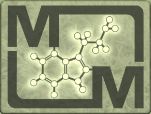 |
MAGISKA MOLEKYLERS WIKI |
Psychotria
Innehåller: DMT
Innehåll
[göm]Generell information
Psychotria är ett växtsläkte av lågväxande träd i familjen måreväxter (Rubiaceae) och omfattar runt 1900 arter. Växterna har sitt ursprung i tropiska skogar i bland annat Australien och Sydamerika.[1]
Chacruna (Psychotria viridis) är arten som används mest och ingår i traditionella ayahuascarecept.
Aktiva Arter
| Namn | Innehåller |
|---|---|
| Psychotria alba | * [2] **[3] |
| Psychotria brachyceras | Ämne(n) med smärtstillande effekt [4] |
| Psychotria brachypoda | Ämne(n) med smärtstillande effekt [4] |
| Psychotria carthagenensis | 0.2% DMT i torkade blad[5], * [2] |
| Psychotria colorata | Caboclos i Brasilien använder den för sina opiodliknande smärtstillande egenskaper. [4] |
| Psychotria expansa | DMT ? [5] |
| Psychotria forsteriana | DMT ? [5] |
| Psychotria horizontalis | * [2] |
| Psychotria insularum | DMT ? [5] |
| Psychotria leiocarpa | Ämne(n) med smärtstillande effekt[4], * [2] |
| Psychotria marginata | * [2] |
| Psychotria myriantha | Ämne(n) med smärtstillande effekt[4] |
| Psychotria poeppigiana | DMT ? [5], * [2] **[3] |
| Psychotria rostrata | DMT ? [5] |
| Psychotria rufipilis | DMT ? [5] |
| Psychotria stenostachya | * [2] |
| Psychotria suterella | Ämne(n) med smärtstillande effekt[4] |
| Psychotria viridis | 0.10 - 0.34% DMT, * [2] |
Märkta med ? = Hänvisar till osäkra källor som hamnat i en Wikipedia-artikel[5] och ska tolkas med skepsis.
Märkta med * = Har enligt Trout[2] förekommit i tillredningen av Ayahuasca.
Märkta med ** = Har analyserats av användare på DMT Nexus 2014[3] och konstaterats sakna DMT eller närbesläktade tryptaminer.
Om arter med smärtstillande effekter
| “ | Plant species of the genus Psychotria (RUBIACEAE) have been extensively studied, particularly due to the presence of bioactive alkaloids. An ethnopharmacological survey indicate that alkaloids of Psychotria colorata (willd ex R. & S.) Müll. Arg., used by Amazonian caboclos of the Pará State (Brazil) as pain killer, bear strong opioid-like analgesic activity. The purpose of this work was to study species of Psychotria collected in the State of Rio Grande do Sul concerning the presence of alkaloids and their possible analgesic activity. Ethanolic extracts of the following species were evaluated: Psychotria carthagenensis Jacq., Psychotria brachyceras Müll. Arg., Psychotria leiocarpa Cham. et Schlecht, Psychotria myriantha Müll. Arg., Psychotria suterella Müll. Arg. and Psychotria brachypoda (Müll. Arg.) Britton. All ethanolic extracts presented strong positive reaction in tests for alkaloids detection, except for P. carthagenensis. All extracts were administered to mice (i.p.) for the evaluation of analgesia (tail-flick), effects on body temperature and toxicity. In the analgesia test, the activity of the extracts of P. brachyceras Müll. Arg., P. leiocarpa Cham. et Schlecht, P. myriantha Müll. Arg., P. suterella Müll. Arg was not dose-related, not reversible by Naloxone and seems to be nonspecific. The extract of P. carthagenensis was inactive in the tail-flick test. The extract of P. brachypoda exhibited a dose-related analgesic activity, reversible by Naloxone, indicating an opioid-like analgesic activity. Body temperature was significantly decreased after administration of all extracts, suggesting activity of central origin. This is consistent with the well-known decreasing effect on body temperature by drugs that act on the central nervous system. Toxicity evaluation showed decreased motor activity and ptoses in all animals. Eventual deaths were preceded by respiratory depression, cyanoses and clonic and tonic convulsions. In order to verify if alkaloids were responsible for the bioactivity of the ethanolic extracts, an alkaloid extract of the leaves of P. brachyceras was prepared, as this species is strongly positive for alkaloids and easily accessible for bulk collection. Despite not having opioid-like analgesic activity, the alkaloidic extract of P. brachyceras allows to infer that the alkaloids are mainly responsible for the bioactivity of the ethanolic extracts, as lower doses of the alkaloidic extract caused the same effects as the ethanolic extracts in the tail flick and body temperature. Furthermore, both the alkaloidic extract of P. brachyceras and the ethanolic extract of P. brachypoda exhibited a similar toxic profile. This work confirms the toxicity observed popularly for some species of Psychotria and indicates the validity of isolating alkaloids from P. brachypoda and characterizing its pharmacological profile. It also confirms the validity of combining ethnopharmacological and chemotaxonomic as approaches to complementary in the search for new drugs of vegetal origin. — Psychopharmacological Study On Psycothria Species (Rubiaceae) From The State Rio Grande Do Sul (Leal, 1994)[4] |
” |
Externa länkar
- ↑ Wikipedia: Psychotria
- ↑ 2,0 2,1 2,2 2,3 2,4 2,5 2,6 2,7 2,8 Ayahuasca: alkaloids, plants & analogs - Descriptions for some of the species used in brewing ayahuasca or jurema
- ↑ 3,0 3,1 3,2 DMT Nexus: Psychotria, Diplopterys & Aya Admixtures Analysis Thread
- ↑ 4,0 4,1 4,2 4,3 4,4 4,5 4,6 Psychopharmacological Study On Psycothria Species (Rubiaceae) From The State Rio Grande Do Sul (Leal, 1994)
- ↑ 5,0 5,1 5,2 5,3 5,4 5,5 5,6 5,7 Wikipedia: Psychedelic plants (en)
Sidan ändrades senast 1 januari 2015 klockan 12.09.
Den här sidan har visats 7 677 gånger.











